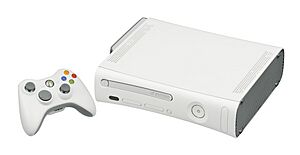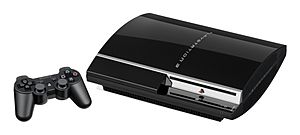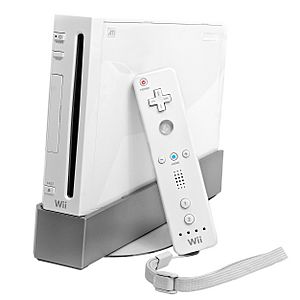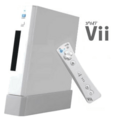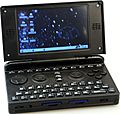Seventh generation of video game consoles facts for kids
The seventh generation of home video game consoles started on November 22, 2005. This was when Microsoft launched its Xbox 360 console. Later, Sony released the PlayStation 3 on November 17, 2006. Nintendo's Wii came out on November 19, 2006.
Each of these new consoles brought exciting new technology. The Xbox 360 showed games in clear high-definition video (HD). The PlayStation 3 could play HD movies using its built-in Blu-ray Disc player. The Wii was special because it used controllers with movement sensors. Players could move these controllers to control actions in games, making it feel like they were really doing the actions.
During this time, video game consoles became a big part of the world's computer systems. By 2007, it was thought that game consoles made up 25% of all the world's general computing power.
Other companies also made motion-sensing devices. Sony released the PlayStation Move in September 2010. It was like the Wii, using motion to play games. In November 2010, Microsoft launched Kinect for the Xbox 360. Kinect was unique because it didn't use controllers at all! It used cameras to see the player's body movements. This meant players became the "controllers" themselves. Kinect sold eight million units in its first 60 days. This earned it a Guinness World Record for being the "fastest selling consumer electronics device."
For handheld consoles, the seventh generation began a bit earlier. The Nintendo DS came out in November 2004. The PlayStation Portable (PSP) followed in December. The DS had a touch screen and a microphone. It also supported wireless connections. The PSP was the first handheld to use optical discs (like mini-DVDs) for games. Sony also made the PSP a multimedia device. It could connect to the PlayStation 3, PlayStation 2, and other PSPs. It also had Internet access. Even though both sold well, the PSP always sold less than the DS.
A console called the Ouya was funded by people online. It got $8.5 million in preorders before it launched in 2013. But after it launched, it didn't sell well and was a commercial failure. Other small consoles, called microconsoles, also tried to compete. These included the Nvidia Shield Console and Amazon Fire TV. However, they are usually not called "seventh generation" consoles.
The seventh generation slowly ended as Nintendo stopped making the Wii in the early 2010s. In 2014, Sony stopped making the PSP. New games for the DS also stopped coming out by 2016. Microsoft announced in 2016 that they would stop making the Xbox 360. The next year, Sony said they would soon stop making the PlayStation 3. Around that time, the last Wii consoles were also stopped. This marked the end of the generation as all the main hardware was discontinued. The last physical Xbox 360 games, FIFA 19 and Just Dance 2019, came out in 2018. Some Wii games were released even later. The eighth generation had already begun in early 2011 with the Nintendo 3DS.
Home Video Game Consoles
Xbox 360
The Xbox 360 quickly became popular. This was mainly because of its online gaming system, Xbox Live. It also launched a year before its rivals. Sales in North America and Europe stayed strong, even after the Wii and PlayStation 3 came out. In Japan, the Xbox 360 wasn't as popular. This was because it didn't have many games for Japanese players. Even with its early start, the Xbox 360 ended up in third place in total sales.
The early launch also brought some problems. Some Xbox 360 consoles had technical issues. The most famous problem was the "red ring of death." This got a lot of attention because some users had to replace their consoles many times. Microsoft tried to fix this by offering a three-year warranty and free repairs. They also changed the console's design to make it more reliable.
People often compared the Xbox 360 and PlayStation 3. The PS3 used Blu-ray discs, while the Xbox 360 used standard DVD9 discs. The Xbox 360 was cheaper to make. Experts also thought the Xbox 360's design was easier for game developers to work with.
By mid-2007, Xbox 360 sales dropped as the Wii became more popular. Sony also lowered the price of the PlayStation 3. To boost sales, Microsoft released the highly anticipated game Halo 3 in September 2007. This worked, and the Xbox 360 outsold the Wii that month in North America. Microsoft's gaming division made a profit for the first time in two years.
The Xbox 360 focused on big games, like new Halo titles. In 2007, it won many awards. At a conference in 2008, Microsoft said they expected over 1,000 games for the Xbox 360 by the end of the year. Many games that were first planned only for PS3, like Grand Theft Auto IV and Final Fantasy XIII, also came out on Xbox 360.
In November, Microsoft released Kinect. Kinect let players control games with their body movements, without a controller. It sold eight million units in its first 60 days. This made it the "fastest selling consumer electronics device." At E3 2010, Microsoft showed a new, slimmer Xbox 360 called the Xbox 360 S. In 2013, they released the Xbox 360 E, which was the last version before the Xbox One.
PlayStation 3
Sony's PlayStation 3 came out on November 11, 2006, in Japan. It launched on November 17, 2006, in the US and Canada. The console used new technologies like the Cell microprocessor and Blu-ray format. This made it hard to make, especially the Blu-ray parts. This led to shortages when it launched and delays in Europe. But by December 2006, Sony said all production problems were fixed.
Sony and market experts believed the success of the PlayStation 3 and Blu-ray format depended on each other. They thought the PS3 would help Blu-ray movies become popular, and Blu-ray would help the PS3 succeed.
Sony supported its console with new games from popular series like Gran Turismo and God of War. They also got many big games from other companies, like Metal Gear Solid 4: Guns of the Patriots. However, some games that were first planned only for PlayStation, like Devil May Cry, also came out on other consoles. Grand Theft Auto IV was released on both Xbox 360 and PlayStation 3 at the same time. Sony blamed lower sales on losing exclusive games, its higher price, and not having enough consoles in stores.
The PlayStation 3's high launch price was a big reason it wasn't as popular at first. In July 2007, Sony lowered the price of some models in the US and Canada. In October 2007, Sony dropped the price again. They also released a new, cheaper 40 GB model. This new model did not play PS2 games. Within weeks, sales of the 40 GB and 80 GB models jumped by 192%. In November 2008, Sony launched a 160 GB model. On August 18, 2009, Sony announced the PS3 Slim. The PS3 Slim sold 1 million units in less than a month.
In September 2012, Sony announced an even slimmer PS3 redesign, often called the "Super Slim" PS3. It came with either a 250 GB or 500 GB hard drive. The "Super Slim" was the last model Sony made. Shipments to the United States stopped in October 2016. Sony officially stopped selling new units in Japan on May 29, 2017.
Wii
Nintendo took a new approach with its Wii console. They wanted to attract all kinds of players: serious gamers, casual players, and even people who didn't usually play games. They focused on new ways to play and interact with games, rather than just having the best graphics or most expensive technology. This idea had worked well for their handheld Nintendo DS. Nintendo hoped their new motion controls would make older consoles seem outdated.
This strategy worked very well. Demand for the Wii was so high that Nintendo couldn't make enough consoles throughout 2007. Unlike its competitors, Nintendo made a profit on each Wii console from the start. This led to very good financial results. Most months, the Wii sold more worldwide than the Xbox 360 and PlayStation 3. It quickly became the market leader in home console sales for that generation.
Nintendo supported the Wii with games from its famous series like Mario, The Legend of Zelda, and Pokémon. To attract casual players, Nintendo made a group of core Wii games. These included Wii Sports, Wii Play, and Wii Fit. In these games, players used the motion controls to pretend they were doing real-world activities.
Some other game companies released exclusive games for the Wii. But the Wii's most popular games were usually Nintendo's own titles. Some game developers were frustrated that their games didn't sell as well on the Wii. However, others were happy with their sales.
In early 2008, data showed that while the Wii had a low "attach rate" (meaning fewer games sold per console), it was still doing very well. This was because so many people were buying the console itself. A fast-growing number of console owners is good for game developers.
Comparison
| Console | Xbox 360 | PlayStation 3 | Wii |
|---|---|---|---|
| Logo |  |
 |
|
| Manufacturer | Microsoft | Sony Interactive | Nintendo |
| Image(s) | 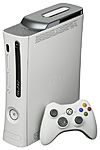 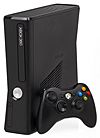 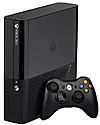 |
   |
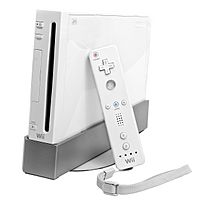 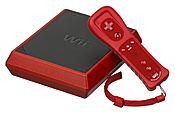 |
| Top: An original model Xbox 360 Premium and controller Middle: A redesigned model Xbox 360 S and controller Bottom: The latest model Xbox 360 E and controller |
Top: An original model PlayStation 3 and DualShock 3 controller Middle: A "slim" model PlayStation 3 and DualShock 3 controller Bottom: A "super slim" model PlayStation 3 and DualShock 3 controller |
Top: An original model Wii and Wii Remote Bottom: A Wii Mini and Wii Remote Plus |
|
| Release dates | More... |
|
Wii:
Wii Family Edition:
Wii Mini:
|
| Discontinued |
|
|
Wii/Wii Family Edition:
|
| Units sold | >84 million | >87.4 million | 101.63 million |
| Media | DVD-DL | Blu-ray Disc | Wii Optical Disc (special DVD-DL) |
| Best-selling game |
Kinect Adventures (came with Kinect peripheral), 24 million |
Grand Theft Auto V, 17.27 million |
Wii Sports (came with, except in Japan), 82.87 million (As of March 31, 2019) |
| CPU | 3.2 GHz IBM PowerPC tri-core "Xenon" | Cell Broadband Engine (3.2 GHz Power ISA 2.03-based PPE with seven 3.2 GHz SPEs) | 729 MHz PowerPC-based IBM "Broadway" |
| GPU | 500 MHz "Xenos" (ATI custom design) | 550 MHz RSX 'Reality Synthesizer' (based on NVIDIA G70 architecture) | 243 MHz ATI "Hollywood" |
| Memory | 512 MB GDDR3 @ 700 MHz shared between CPU & GPU 10 MB EDRAM GPU frame buffer memory |
256 MB XDR @ 3.2 GHz 256 MB GDDR3 @ 650 MHz |
24 MB "internal" 1T-SRAM 64 MB "external" GDDR3 SDRAM 3 MB GPU frame buffer memory |
| Dimensions |
Original: 310 × 80 × 260 mm (12.2 × 3.2 × 10.2 in) |
Original: 325 × 98 × 274 mm (12.8 × 3.9 × 10.8 in) |
Wii / Wii Family Edition: 4.4 × 16 × 21.5 cm (1,513.6 cm3) / 1.7 × 6.3 × 8.5 in (92.4 in3) |
| Weight |
Original: 3.5 kg (7.7 lb) |
Original: 5 kg (11 lb) |
Wii / Wii Family Edition: 1.2 kg (2.6 lb) |
| Included accessories |
250 GB "Super Elite" consoles come with 2 Wireless controllers. 320 GB Xbox 360 S consoles come with a "transforming d-pad" controller. |
|
|
| Accessories (retail) |
see Xbox 360 accessories |
see PlayStation 3 accessories |
|
| Controller |
|
|
|
| User interface | Xbox 360 Dashboard New Xbox Experience (NXE) |
XrossMediaBar (XMB) | Wii Menu |
| System software features |
|
||
| Backward compatibility | 465 Selected Xbox games (as of November 2007). Additions made with software updates. Official Xbox hard drive required. | The first generation model is backwards compatible with PS1 and PS2 titles.
The second generation model offers less backward compatibility for PS2 titles. Third and later generation models dropped support for all PS2 discs, but some games are available digitally. All PS3 models will play most PS1 discs. |
Supports all Nintendo GameCube software and most accessories. The "Family Edition" and "Mini" models do not support GameCube games. |
| Online services |
Xbox Live |
Remote Play |
Nintendo Wi-Fi Connection |
| Video and entertainment services |
4oD* (UK Only; Xbox Live Gold required) |
4oD (UK only, via internet browser) |
BBC iPlayer (UK only) |
| Consumer programmability | Development on PC with XNA Game Studio ($99/year subscription, binary distribution with XNA 1.0 Refresh) | Featured development on console (excluding RSX graphics acceleration) via free Linux platform or PC (excluding all Slim models and any console updated to firmware 3.21 and later) | Homebrew Channel (Unofficial) |
| I/O |
IrDA-compliant infrared for remote |
Bluetooth 2.1 EDR *2 USB 2.0 ports on 3rd gen and 4th gen (slim) models |
Bluetooth 2.0 |
| Optical media | 12× DVD (65.6–132 Mbit/s), CD | 2× BD-ROM (72 Mbit/s), 8× DVD, 24× CD, 2× SACD* *Compatibility removed in 3rd & 4th gen models |
Wii Optical Disc, Nintendo GameCube Game Disc (DVD-Video playback was announced for Japan in 2007, but has not been released) |
| Video outputs | HDMI 1.2a (on models manufactured after August 2007), VGA (RGBHV), Component/D-Terminal (YPBPR), SCART (RGBS), S-Video, Composite | HDMI 1.3a, Component/D-Terminal (YPBPR), SCART (RGBS), S-Video, Composite | Component/D-Terminal (YPBPR), SCART (RGBS), S-Video, Composite |
| Resolutions | HDTV-capable (480i, 480p, 576i (50 Hz), 576p, 720p, 1080i, 1080p) Various monitor resolutions available via VGA and HDMI/DVI (640×480, 848×480, 1024×768, 1280×720, 1280×768, 1280×1024, 1360×768, 1440×900, 1680×1050 & 1920×1080) |
HDTV-capable (480i, 480p, 576i, 576p, 720p, 1080i, 1080p) | EDTV-capable (240p, 480i, 480p, 576i) |
| Audio | Dolby Digital, WMA Pro, DTS*, DTS-ES* *(DVD and HD DVD movies only)
|
Dolby Digital, DTS, Dolby Digital Plus*, Dolby TrueHD*, DTS-HD Master Audio*, DTS-HD High Resolution Audio*, DTS-ES‡, DTS 96/24‡, DTS-ES Matrix† *DVD and Blu-ray movies only. ‡DVD movies only. †Blu-ray movies only.
|
Dolby Pro Logic II surround, stereo sound and an additional Mono speaker is built into the controller.
|
| Network | 100BASE-TX Ethernet Optional 802.11a/b/g/n Wi-Fi adapter (Built in with the Slim models) |
10BASE-T/100BASE-TX/1000BASE-T Ethernet Built-in 802.11 b/g Wi-fi (all models except 20 GB) |
Built-in 802.11 b/g Wi-fi Optional Ethernet via USB adapter |
| Storage |
Included/Optional* detachable SATA upgradeable 20 GB, 60 GB, 120 GB, 250 GB, 320 GB, or 500 GB hard drive. |
2.5-inch upgradeable SATA hard drive (upgradeable with any 2.5-inch SATA 1.0 compliant HDD or SSD). |
512 MB built-in flash memory |
| Integrated 3DTV support | Yes | No | Yes |
Game packages not listed. Bundles, special editions and limited editions may include additional or exchanged items.
There is a variety of other input devices available for all three consoles, including rhythm game controllers, microphones and third-part gamepads/controllers.
All consoles are capable of producing 3D images using anaglyph or frame-compatible systems (side-by-side/SbS, top and bottom/TaB), as these do not require any special output hardware. As such, these display modes are dependent on the software being displayed rather than the console.
Facebook and Twitter apps for Xbox 360 were retired in October 2012.
Sales Standings
These numbers show how many consoles were sold around the world. The numbers for Canada and the United States come from the NPD Group. Japan's numbers are from Famitsu/Enterbrain. The United Kingdom's numbers are from GfK Chart-Track.
| Region | Wii | PlayStation 3 | Xbox 360 | Total |
|---|---|---|---|---|
| Australia | 2 million (as of October 2010) |
1.8 million (as of December 31, 2010) |
1.2 million (as of April 20, 2010 and include sales from New Zealand) |
4.2 million |
| Canada | 2 million (as of December 16, 2009) |
2 million (as of October 6, 2010) |
870,000 (as of July 31, 2008) |
4.4 million |
| Europe | 25 million (as of December 2010) |
15.7 million (as of December 2010) |
13.7 million (as of December 2010) |
53.4 million |
| Japan | 12.75 million (as of December 31, 2013) |
11 million (as of April 11, 2010) |
1.5 million (as of February 28, 2010) |
24.0 million |
| United States | 39 million (as of February 28, 2011) |
16.9 million (as of December 2010) |
25.6 million (as of December 2010) |
79.8 million |
| Worldwide | 101.63 million (as of June 30, 2017) |
87.4 million (as of March 31, 2017) |
84 million (as of June 9, 2017) |
273.03 million |
Changes and Updates
- The PlayStation 3 20 GB model was stopped in North America in April 2007.
- The PlayStation 3 60 GB model was stopped in most places by September 2007. It was replaced by an 80 GB version.
- Sony announced that the PlayStation 2's special chip would be removed from the PS3 for Europe. This was to save money. So, later PS3s used software to play PS2 games.
- An HDMI port was added to the Xbox 360 Premium in May 2007.
- The Xbox 360 Core system was stopped and replaced by the "Arcade" version in October 2007.
- The price of the Xbox 360 Premium was lowered to US$299 in North America on July 13, 2008. It was replaced by a 60 GB model.
- The PlayStation 3 40 GB was stopped in August 2008. The new 80 GB version took its place.
- The Xbox 360 Arcade with 256 MB of memory was stopped in early 2009. A new 512 MB version, still called Xbox 360 Arcade, was released.
- The PlayStation 3 Slim came out on August 18, 2009. It was US$100 cheaper and lighter. It also used less energy.
- The black Wii console was released in Japan in August 2009 and in Europe in November 2009.
- In North America, the Wii package started including Wii Sports Resort and the Wii MotionPlus accessory in May 2010. The console also became available in black.
- A special red Wii console was released for Super Mario Bros. 25th Anniversary.
- The Xbox 360 S was announced at E3 2010. It was a smaller Xbox 360 with built-in Wi-Fi and a port for the Kinect sensor.
- The Wii Family Edition was released on October 23, 2011. It could not play GameCube games.
- The PlayStation 3 Super Slim was released on September 25, 2012. It had a sliding disc cover.
- The Wii Mini was released on December 7, 2012. It had a top-loading disc drive and no Wi-Fi.
- The Xbox 360 E was shown and released at E3 2013. It had a new, quieter design.
Playing Older Games
Early Wii consoles could play GameCube games and use most GameCube accessories. However, the Wii Family Edition and Wii Mini could not. Early PlayStation 3 models and all Xbox 360 models could play some older games using software emulation. Later PS3 models could not play PlayStation 2 discs, but they could still play PS1 games. The Xbox 360's ability to play older games was improved with updates. The PS3's compatibility was also updated.
All three consoles let you download games from older systems. The Xbox 360 had Xbox Originals. The PlayStation 3 had the PlayStation Store. The Wii had the Virtual Console. When you bought a game, it saved to the console's memory. The Xbox 360 used to support Xbox Live for older Xbox games, but this service has stopped. Many popular PS2 games were also released as "PS2 Classics" for download on the PlayStation Store. Some popular series were updated with better graphics as high-definition remasters for PlayStation consoles.
HDTV Video and Services
Both the PlayStation 3 and the Xbox 360 could show games in 1080p HD. Sometimes, you needed a special TV if you used an HDMI cable. The Xbox Live Marketplace and PlayStation Store offered HD movies, TV shows, and trailers to download.
While only a few games showed video in native 1080p, many games could be automatically adjusted to that resolution. The Wii could show 480p for its menu and most games. You needed to buy a separate component cable for this.
Reliability
In a survey from September 2009, over 5,000 readers shared their experiences. 54.2% of Xbox 360 owners said their console had broken down. For PlayStation 3, it was 10.6%, and for Wii, it was 6.8%.
In August 2009, a company called SquareTrade looked at warranty claims. They found that 23.7% of Xbox 360s broke in the first two years. For PlayStation 3, it was 10.0%, and for Wii, it was 2.7%.
Handheld Systems
For handheld game consoles, the seventh generation began with the Nintendo DS on November 21, 2004. This handheld was very different from the older Game Boy. The Nintendo DS had new ways to play, like a touch screen and a microphone. It could also connect wirelessly. On December 12, 2004, Sony released its first handheld, the PlayStation Portable. The PSP was aimed at older, more serious gamers. The Nintendo DS, however, became popular with both serious gamers and new players.
Nokia also updated its N-Gage platform. It became a service for certain phones. This new service launched on April 3, 2008. Other less popular handhelds from this time included the Gizmondo (2005-2006) and the GP2X (2005-2008).
Another big change in this generation was the rise of powerful phones and PDAs, like the iPhone and iPod Touch. These devices started to compete directly with dedicated gaming handhelds. Simple games had been on PDAs for a while. But by 2009, phones and PDAs were strong enough to run complex games. They also had the advantage of downloading games wirelessly.
Sony announced in 2014 that they had stopped making the PlayStation Portable worldwide.
Handheld Game Console Comparison
| Product Line | Nintendo DS family | PlayStation Portable | ||
|---|---|---|---|---|
| Console | Nintendo DS / Nintendo DS Lite / Nintendo DSi / Nintendo DSi XL | PSP-1000 / PSP-2000 / PSP-3000 / PSP Go / PSP-E1000 | ||
| Manufacturer | Nintendo | Sony (SCE) | ||
| Console |    
|
   
|
||
| Release dates |
|
PSP:
|
||
| Discontinuation | Yes; date undisclosed | 2014 | ||
| Media | Nintendo DS Game Card, Game Boy Advance cartridge (DS, DS Lite only), SD (HC) Card (DSi only) | Universal Media Disc (UMD) (PSP-1000, PSP-2000, PSP-3000 and PSP-E1000 series only), Memory Stick Duo (PSP-1000, PSP-2000, PSP-3000 series only), Memory Stick Micro (M2), Flash memory (PSP Go only), Content delivery via PSN (All) | ||
| Best-selling game | New Super Mario Bros., 30.80 million (as of March 31, 2019) | Grand Theft Auto: Liberty City Stories 2 million (as of Fall 2008) | ||
| Included accessories and extras |
|
|
||
| Accessories (retail) |
|
|
||
| CPU | DS and DSL: 67 MHz ARM9 and 33 MHz ARM7 DSi: 133 MHz ARM9 and 33 MHz ARM7 |
MIPS R4000-based; clocked from 1 to 333 MHz (2 of these) | ||
| Memory | DS and DSL: 4 MB SRAM DSi: 16 MB |
EDRAM (5 MB reserved for kernel, 3 for music) PSP-1000: 32 MB PSP-2000, PSP-3000, PSP Go: 64 MB |
||
| Interface |
|
|
||
| Dimensions | DS: 148.7 × 84.7 × 28.9 mm (5.85 × 3.33 × 1.13 inches) DS Lite: 133 × 73.9 × 21.5 mm (5.24 × 2.9 × 0.85 inches) |
PSP 1000: 74 mm (2.9 in) (h) 170 mm (6.7 in) (w) 23 mm (0.91 in) (d) PSP Slim & Lite:71.4 mm (2.81 in) (h) 169.4 mm (6.67 in) (w) 18.6 mm (0.73 in) (d) PSP Go: 69 mm (2.7 in) (h) 128 mm (5.0 in) (w) 16.5 mm (0.65 in) (d) |
||
| Weight | DS: 275 g (9.7 oz) DSL: 218 g (7.7 oz) DSi: 214 g (7.5 oz) DSi XL: 314 g (11.1 oz) |
PSP 1000: 280 g (9.9 oz) PSP Slim & Lite 189 g (6.7 oz) PSP Go: 158 g (5.6 oz) |
||
| Online service | Nintendo Wi-Fi Connection, DSi Shop (DSi only), DSi camera(DSi only), DSi sound(DSi only), Internet browser(DSi only), Flipnote Hatena(DSi only), Facebook(DSi XL only) | PlayStation Network, RSS reader, Skype (PSP-2000 series, PSP-3000 series and PSP Go only), PlayStation Store
Internet browser, Digital comics, Remote Play |
||
| Backward compatibility | Game Boy Advance (DS, DS Lite only) | PlayStation (downloadable PSone Classics only), TurboGrafx-16/TurboGrafx-CD (via PlayStation Store), Neo Geo (via PlayStation Store) | ||
| System software | Nintendo DS Menu (DS, DS Lite), Nintendo DSi Menu (DSi) | XrossMediaBar (XMB) | ||
| Consumer programmability | See Nintendo DS homebrew | See PlayStation Portable homebrew | ||
| Resolutions | 256 × 192 (both screens) | 480 × 272 | ||
| Colors | 18-bit color (about 260k colors) | 24-bit color (about 17m colors) | ||
| Network | Wi-Fi 802.11b, Wi-Fi 802.11g (DSi only, only functions with DSi-specific software), wireless ad hoc with other DS units and Nintendo Wii | Wi-Fi 802.11b (PSP-1000, PSP-2000, PSP-3000 and PSP Go only), IrDA (PSP-1000 series only), Bluetooth (PSP Go only), wireless ad hoc with other PSP units and PS3 | ||
| Audio | Stereo speakers, headphone jack, with 16 PCM/ADPCM channels | Stereo speakers, headphone jack | ||
| I/O | 1 Nintendo DS Game Card slot 1 GBA slot (DS, DS Lite only) 1 SD (HC) card slot (DSi Only) |
UMD drive (PSP-1000, PSP-2000, PSP-3000 and PSP-E1000 series only) 1 USB device port (proprietary connector on PSP Go, mini-b connector on other models) 1 Memory Stick Duo/PRO Duo slot (Memory Stick Micro (M2) on PSP Go) 1 IrDA (PSP-1000 series only) |
||
| Storage | Nintendo DS Game Card, SD (HC) card (DSi only) | Memory Stick Duo/PRO Duo (Memory Stick Micro (M2) on PSP Go), 16 GB flash memory (PSP Go only) | ||
| Battery life | DS, backlight on: 14 hours DS Lite, minimum brightness setting: 15–19 hours DSi, minimum brightness setting: 9–14 hours |
MP3 playback: 10 hours Game: approximately 3–6 hours Video playback: 3–7 hours depending on screen brightness setting Wi-Fi internet browsing: approximately 3–4 hours |
||
| Units sold (all models combined) | Worldwide: 154.02 million (as of September 31, 2016) Japan: 32.99 million (as of December 31, 2013) |
Worldwide: 82 million (as of June 2016)
Japan: 11,078,484 (as of December 28, 2008) |
Note: First year of release is the first year of the system's worldwide availability.
Other Systems
Other consoles were also released during the seventh generation. These were usually for a smaller group of players or were less powerful.
Other Home Video Game Consoles
| Console | Manufacturer | Release date | Notes |
|---|---|---|---|
| EVO Smart Console | Envizions | 2006 | Can be considered as a Media PC |
| Zeebo | Zeebo Inc. | 2009 | Made for developing countries. Sold in Mexico, Brazil and China only |
| HyperScan | Mattel | 2006 | Made for children |
| Game Wave Family Entertainment System | ZAPiT Games | 2005 | Had family-friendly games built-in |
| Vii | JungleTac | 2007 | A Chinese copy of the Wii |
| V.Flash | VTech | 2006 | |
| V.Smile V-Motion | VTech | 2008 | |
| V.Smile Baby | VTech | 2006 | |
| ClickStart | LeapFrog | 2007 | |
| Swinxs | Swinxs BV | 2008 | Screenless, portable game console for children. |
Other Handhelds
| Name | Manufacturer | Release date | Notes |
|---|---|---|---|
| N-Gage 2.0 Platform | Nokia | April, 2008 | Plays commercial downloadable games |
| Gizmondo | Tiger Telematics | March, 2005 in UK, Sweden and eventually US | Plays commercial games |
| VideoNow XP | Tiger Electronics | 2005 | |
| digiBlast | Grey Innovation | late 2005 | Multimedia system for young children |
| CAANOO | GamePark Holdings | August 16, 2010 | Runs emulators |
| Fusion: 30-In-1 Portable Arcade | Jungle Soft | 2010? | Had built-in games |
| GP2X Wiz | GamePark Holdings | May 12, 2009 | |
| Leapster2 | LeapFrog Enterprises, Inc. | 2008 | Educational games |
| Leapster Explorer | LeapFrog Enterprises, Inc. | 2010 | Educational games and downloadable apps |
| Mi2 / PDC Touch | Planet Interactive / Conny Technology / Videojet | November 2009 – Benelux, China, France, Spain, Germany, United Kingdom, Portugal |
Many built-in games |
| Pandora | OpenPandora | May 2010 | Runs on Linux and made for homebrew games |
| Pelican VG Pocket | Pelican Accessories | August 2006 |
Released in China only
| Name | Manufacturer | Release date |
|---|---|---|
| Dingoo A320 | Shenzhen Dingoo Digital Co., Ltd. | March 2009 |
| Ez MINI | Mitac or Mio | 2005 |
| Gemei X760+ | Gemei | 2009 |
| LetCool N350JP | 2011 |
Released in South Korea only
| Name | Manufacturer | Release date |
|---|---|---|
| GP2X | GamePark Holdings | November 10, 2005 |
Clones
Cloud Gaming Services
These services let you play games over the internet without needing to download them.
| Name | Manufacturer | Release date |
|---|---|---|
| OnLive | OnLive | June 17, 2010 |
| Gaikai | Gaikai | February 27, 2011 |
| OTOY | OTOY | |
| Playcast Media Systems | ||
| G-cluster | ||
| Spoon.net |
Images for kids
See also
 In Spanish: Videoconsolas de séptima generación para niños
In Spanish: Videoconsolas de séptima generación para niños
- 2000s in video games
- Sixth generation of video game consoles (1998–2000s)
- Eighth generation of video game consoles (2012–)
- Ninth generation of video game consoles (2020-)
- List of video game consoles


